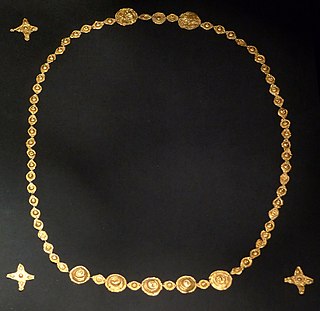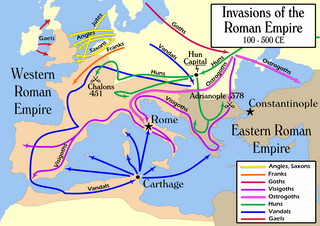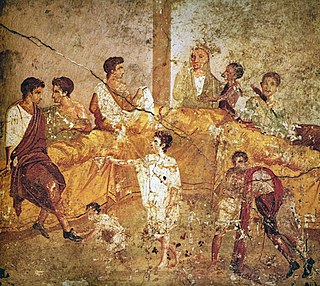
The Germanic peoples were tribal groups who lived in Northern Europe in Classical Antiquity and the Early Middle Ages. In modern scholarship, they typically include not only the Roman-era Germani who lived in both Germania and parts of the Roman empire, but also all Germanic speaking peoples from this era, irrespective of where they lived, most notably the Goths. Another term, ancient Germans, is considered problematic by many scholars since it suggests identity with present-day Germans. Although the first Roman descriptions of Germani involved tribes west of the Rhine, their homeland of Germania was portrayed as stretching east of the Rhine, to southern Scandinavia and the Vistula in the east, and to the upper Danube in the south. Other Germanic speakers, such as the Bastarnae and Goths, lived further east in what is now Moldova and Ukraine. The term Germani is generally only used to refer to historical peoples from the 1st to 4th centuries CE.

The Heruli were one of the smaller Germanic peoples of Late Antiquity, known from records in the third to sixth centuries AD. The best recorded group of Heruli established a kingdom north of the Middle Danube, probably including the stretch where Vienna exists today. This kingdom was a neighbour to several other small and short-lived kingdoms in the late 5th century AD and early 6th century, including those of the Sciri, Rugii, Danubian Suebi, and Gepids. After the conquest of this Heruli kingdom by the Lombards in 508, splinter groups moved to Sweden, Ostrogothic Italy, and present-day Serbia, which was under Eastern Roman control.

The Vandals were a Germanic people who were first reported in the written records as inhabitants of what is now Poland, during the period of the Roman empire. Much later, in the fifth century, a group of Vandals led by kings established Vandal kingdoms first within the Iberian Peninsula, and then in the western Mediterranean islands, and North Africa.

The Rugii, Rogi or Rugians, were one of the smaller Germanic peoples of Late Antiquity who are best known for their short-lived 5th-century kingdom upon the Roman frontier, near present-day Krems an der Donau in Austria. This kingdom, like those of the neighbouring Heruli and Sciri, first appears in records after the death of Attila in 453. The Rugii, Heruli, Sciri and others are believed to have moved into this region from distant homelands under pressure from the Huns, and become part of Attila's Hunnic empire which also moved and came to be based in this region. The Rugii were subsequently part of the alliance which defeated Attila's sons and the Ostrogoths at the Battle of Nedao in 454, giving their kingdom independence. In 469 they were part of a similar alliance who lost to the Ostrogoths at the Battle of Bolia, weakening their kingdom significantly.

The Migration Period, also known as the Barbarian Invasions, was a period in European history marked by large-scale migrations that saw the fall of the Western Roman Empire and subsequent settlement of its former territories by various tribes, and the establishment of the post-Roman kingdoms.
Vandalic was the Germanic language spoken by the Vandals during roughly the 3rd to 6th centuries. It was probably closely related to Gothic, and, as such, is traditionally classified as an East Germanic language. Its attestation is very fragmentary, mainly due to the Vandals' constant migrations and late adoption of writing. All modern sources from the time when Vandalic was spoken are protohistoric.
The Vistula Veneti, also called Baltic Veneti, Venedi or Venethi, were an Indo-European people that inhabited the lands of central Europe east of the Vistula River and the Bay of Gdańsk. Ancient Roman geographers first mentioned Venedi in the 1st century AD, differentiating a group of peoples whose manner and language differed from those of the neighbouring Germanic and Sarmatian tribes. In the 6th century AD, Byzantine historians described the Veneti as the ancestors of the Slavs who, during the second phase of the Migration Period, crossed the northern frontiers of the Byzantine Empire.

Rodulf was king of the Heruli kingdom on the Middle Danube in the period around 500, and possibly of Scandinavian origin. He died in a battle in about 508, with the neighbouring Lombards, which led to the splitting up of the Heruli. He is probably the same Heruli king that Theoderic the Great wrote to in two surviving letters which do not mention his name, in one of which Theoderic "adopted" him with a gift of arms. Less certainly, many scholars also equate him to the King Rodulf that Jordanes mentions as having come from Scandinavia to Italy, to join Theoderic.

The Sciri, or Scirians, were a Germanic people. They are believed to have spoken an East Germanic language. Their name probably means "the pure ones".
Peter John Heather is a British historian of late antiquity and the Early Middle Ages. Heather is Chair of the Medieval History Department and Professor of Medieval History at King's College London. He specialises in the fall of the Western Roman Empire and the Goths, on which he for decades has been considered the world's leading authority.

Barbaricum is a geographical name used by historical and archaeological experts to refer to the vast area of barbarian-occupied territory that lay, in Roman times, beyond the frontiers or limes of the Roman Empire in North, Central and South Eastern Europe, the "lands lying beyond Roman administrative control but nonetheless a part of the Roman world". During the Late Antiquity, it was the Latin name for those tribal territories not occupied by Rome that lay beyond the Rhine and the Danube : Ammianus Marcellinus used it, as did Eutropius. The earliest recorded mention appears to date to the early 3rd century.

Walter Pohl is an Austrian historian who is Professor of Auxiliary Sciences of History and Medieval History at the University of Vienna. He is a leading member of the Vienna School of History.
Walter Andre Goffart is a German-born American historian who specializes in Late Antiquity and the European Middle Ages. He taught for many years in the history department and Centre for Medieval Studies of the University of Toronto (1960–1999), and is currently a senior research scholar at Yale University. He is the author of monographs on a ninth-century forgery, late Roman taxation, four "barbarian" historians, and historical atlases.

Gaiseric, also known as Geiseric or Genseric was king of the Vandals and Alans from 428 to 477. He ruled over a kingdom and played a key role in the decline of the Western Roman Empire during the 5th century.
Guy Halsall is an English historian and academic, specialising in Early Medieval Europe. He is currently based at the University of York, and has published a number of books, essays, and articles on the subject of early medieval history and archaeology. Halsall's current research focuses on western Europe in the important period of change around AD 600 and on the application of continental philosophy to history. He taught at the University of Newcastle and Birkbeck, University of London, before moving to the University of York.

The Roman people was the body of Roman citizens (Latin: Rōmānī; Ancient Greek: Ῥωμαῖοι Rhōmaîoi) during the Roman Kingdom, the Roman Republic, and the Roman Empire. This concept underwent considerable changes throughout the long history of the Roman civilisation, as its borders expanded and contracted. Originally only including the Latins of Rome itself, Roman citizenship was extended to the rest of the Italic peoples by the 1st century BC and to nearly every subject of the Roman empire in late antiquity. At their peak, the Romans ruled large parts of Europe, the Near East, and North Africa through conquests made during the Roman Republic and the subsequent Roman Empire. Although defined primarily as a citizenship, "Roman-ness" has also and variously been described as a cultural identity, a nationality, or a multi-ethnicity that eventually encompassed a vast regional diversity.

The barbarian kingdoms were states founded by various non-Roman, primarily Germanic, peoples in Western Europe and North Africa following the collapse of the Western Roman Empire in the fifth century. The barbarian kingdoms were the principal governments in Western Europe in the Early Middle Ages. The time of the barbarian kingdoms is considered to have come to an end with Charlemagne's coronation as emperor in 800, though a handful of small Anglo-Saxon kingdoms persisted until being unified by Alfred the Great in 886.
The Vienna School of History is an influential school of historical thinking based at the University of Vienna. It is closely associated with Reinhard Wenskus, Herwig Wolfram and Walter Pohl. Partly drawing upon ideas from sociology and critical theory, scholars of the Vienna School have utilized the concept of ethnogenesis to reassess the notion of ethnicity as it applies to historical groups of peoples such as the Germanic tribes. Focusing on Late Antiquity and the Early Middle Ages, the Vienna School has a large publishing output, and has had a major influence on the modern analysis of barbarian identity.
Concerning the origin of the Goths before the 3rd century, there is no consensus among scholars. It was in the 3rd century that the Goths began to be described by Roman writers as an increasingly important people north of the lower Danube and Black Sea, in the area of modern Romania, Republic of Moldova, and Ukraine. They replaced other peoples who had been dominant in the region, such as especially the Carpi, and Germanic-speaking Bastarnae. However, while some scholars, such as Michael Kulikowski, believe there is insufficient evidence to come to strong conclusions about their earlier origins, the most commonly accepted proposal is that the Goths known to the Romans were a people whose traditions derived to some extent from the Gutones who lived near the delta of the Vistula in what is now Poland. More speculatively, the Gutones may have been culturally related to the similarly named Gutes of Gotland and the Geats of southern Scandinavia, known from much later historical periods.
Aruth was a Byzantine official of Herul origin, active under Emperor Justinian. It is known that he was married to the unnamed daughter of Mauricius, son of magister militum Mundus. A renowned soldier, he led his fellow Heruli during the expedition to the Ostrogothic Kingdom led by Narses in 552. Upon the death of Fulcarius, he received great support to become the new leader of the Heruli. However, Narses eventually appointed fellow Herul Sindual in preference to him.












